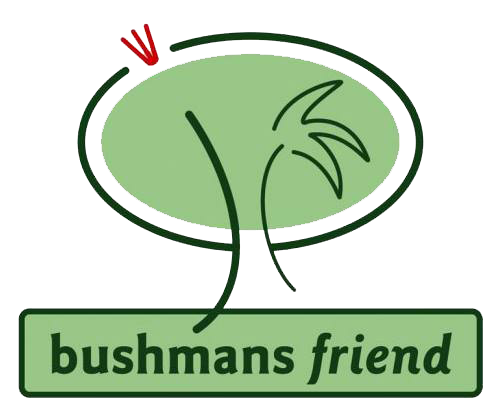
Purchase recommended products The classic New Zealand identification guide. Every home should have one Buy it here. Pohutukawa Diana Adams Art Print |
100 Best NZ Native Plants for Gardens
The classic New Zealand identification guide. Every home should have one Buy it here.
Pohutukawa Diana Adams ArtPrint
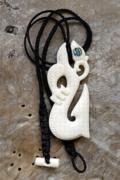
Hand carved Bone, Jade, Wood & Pearl shell pendants, carvings, gifts & art from NewZealand
100 Best NZ Native Plants for Gardens

Pittosporum (pitch or tar seed-referring to the sticky seeds which are found inside a woody capsule).
There are about 70 species of Pittosporum found in South Africa, Asia, Australia and the Pacific. About 25 species found in New Zealand. They are shrubs or small trees. To help with identification use the key from here.
Pittosporum umbellatum Haekaro
Name is from the many flowers found in umbells (like an umbrella, they radiate out from the centre). A tree reaching 6 m. Leaves 5-10cm long, alternate or almost in whorls, leathery and dark green. Pink flowers in many flowered terminal umbels. Capsules 1cm, 4lobed, 2 valved, holding many sticky seeds. Distribution :eastern coastal from North Cape to Gisborne.
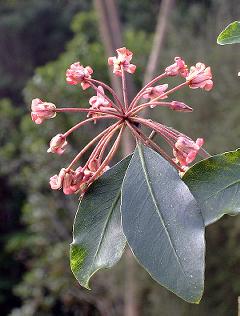 The pink umbel flowers of P. umbellatum
The pink umbel flowers of P. umbellatum
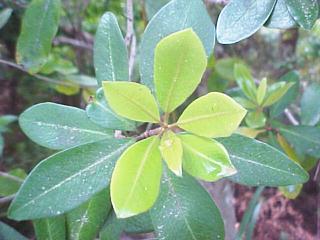 Leaves are found in whorls
Leaves are found in whorls
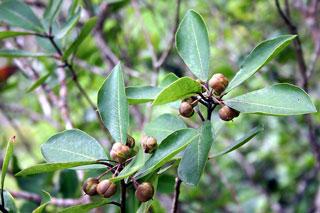 Capsules hold the sticky seeds
Capsules hold the sticky seeds
.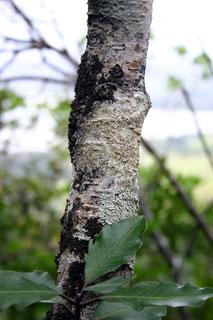 Bark
Bark
Pittosporum cornifolium
Shrub to 2m, usually epiphytic or on rocks. Slender, often drooping branches with thick and glossy leaves 4-7 cm long that occur in whirls. 3-5 flowers in terminal umbels. Capsule 1cm. and bright orange within. North Cape to Marlborough Sounds.
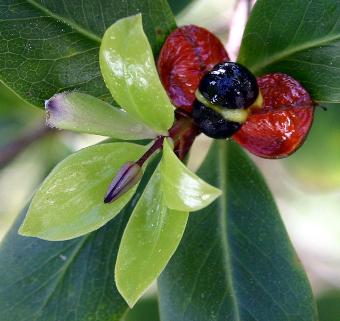
Pittosporum pimelioides & Pittosporum pimelioides subsp majus syn. P. michiei
2 species with a distribution limited to Northland. The flowers and capsules are identical in both plants, however leaf shape varies greatly. Pittosporum michiei is only found at North Cape and Whangaroa in coastal scrub or forest. The leaves are broad oblong10-30mm long in whorls.
Pittosporum michiei has broader leaves than Pittosporum pimelioides var pimelioides
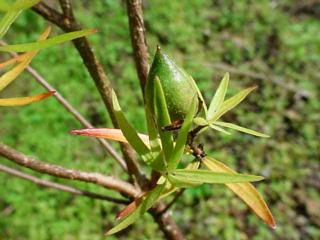 Capsule of pittosporum pimeloides var. pimelioides.
Capsule of pittosporum pimeloides var. pimelioides.
Pittosporum virgatum
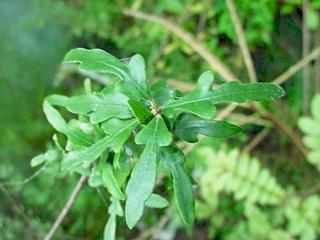 The lobed leaf of Pittosporum virgatum
The lobed leaf of Pittosporum virgatum
Pittosporum crassifolium Karo Coastal Pittosporum
Leaves 5-12 cm. A shrub or small tree to 9m. Karo occurs from the Kermadec Islands to Poverty Bay, mainly near the coast. Its tough, leathery leaves have small hairs on the underside of the leaf, buffering the harsh, drying coastal winds andpreventing excessive evaporation of water from the leaf.
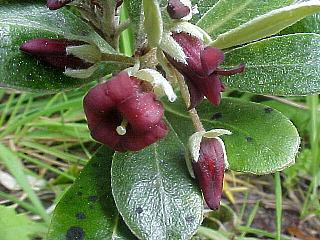 karo produces fragrant flowers.
karo produces fragrant flowers.
Pittosporum eugenoides Tarata.
Leaves 2-7cm long glossy, light green and citrus scented. Tarata is a shrub or small tree reaching 13m. North Cape to South Otago. Distinguishing feature: leaves are citrus scented when crushed. Maori used the leaves and flowers as a scentedgarland.
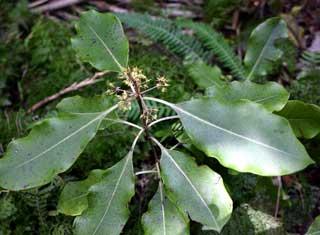 leaf and flowers
leaf and flowers
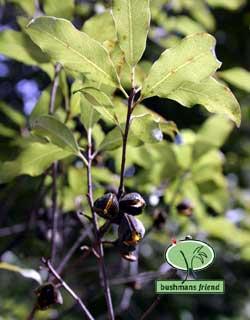 leaf and seed capsules
leaf and seed capsules
Pittosporum tenuifolium
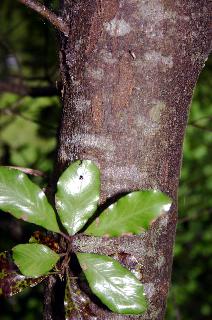 Bark and leaf
Bark and leaf
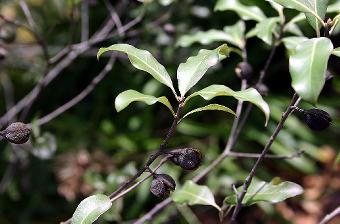 Leaf and seed capsules
Leaf and seed capsules
Pittosporum kirkii
A plant of the northern kauri forests. Often epiphytic. Particularly handsome with the glossy leaves and red petioles.
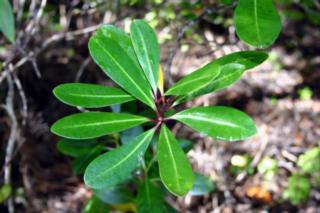
To help with identification use the key from here.
Seed Germination in Pittosporum.
Seed can be gathered from the capsules in autumn. In all cases capture the seed as soon as they open. It is necessary to clean the sticky tar away from the seed. Mix the sticky seeds with sand and shake in a plastic bag. Removal of the tar makes it easier foreven distribution on the seed raising mix. Many people chose to stratify the seeds. This is placing the cleaned seed in the refrigerator for about a month. The idea is that cold storage provides a winter environment for the seed, so when they are removed from the refigeratorthe seeds sense a change of temperature, and believing it to be spring, the seed germinates. Evidence suggests that startification may not improve over all germination, rather, it produces more uniform germination. Sowing seed without stratifcation results in germination ofthe seeds over a longer period of time which may be 2 or 3 years. They sometimes show three or four cotyledons (seed leaves) instead of the usual two.
I recommend the following books on New Zealand native plants
100 Best NZ Native Plants for Gardens
The Reed Field Guide to New Zealand Native Trees
Trees and Shrubs of New Zealand
Gardener's Encyclopaedia of NZ Native Plants
A Photographic Guide to Ferns of New Zealand
New Zealand Trees and Shrubs: A Comprehensive Guide to Cultivation and Identification
From Weta to Kauri: A Guide to the NZ Forest
Which Native Forest Plant? (Which S.)
Articles